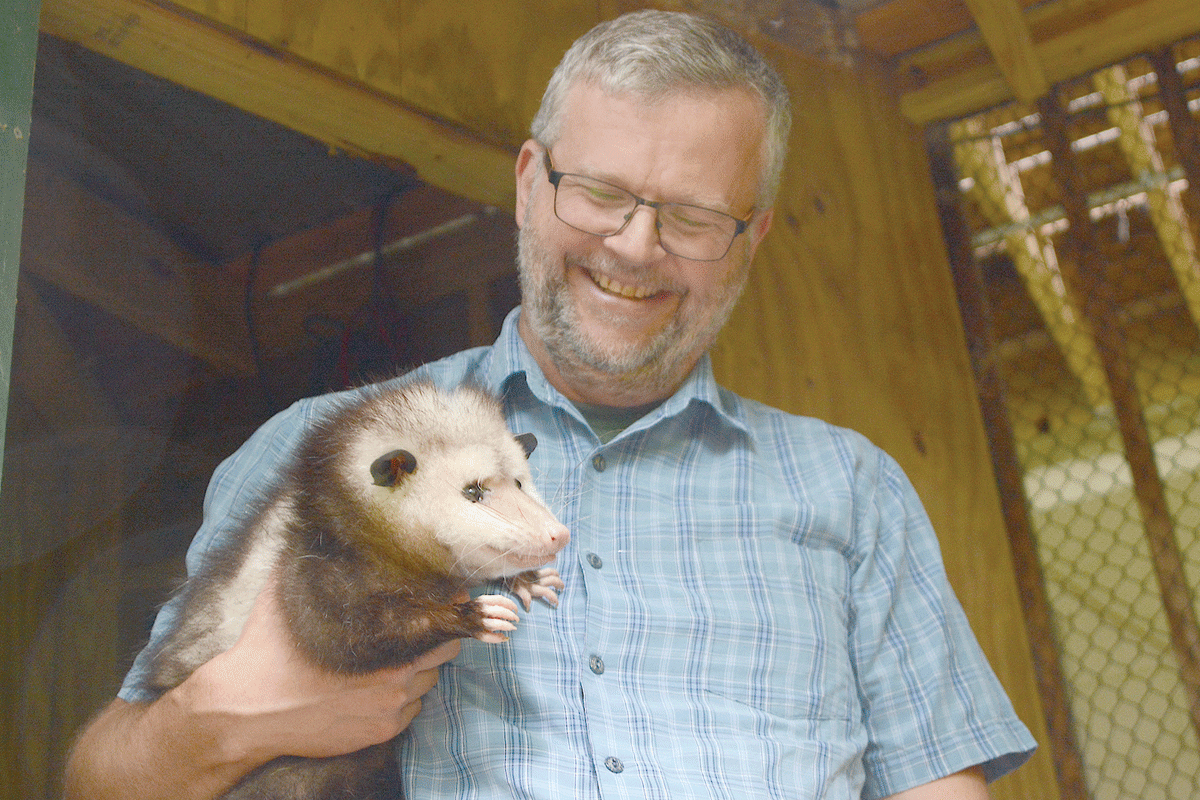Living better together: New Balsam Mountain Trust director aims to make people and wildlife better neighbors
 Wall holds Tillia, a Virginia opossum who is one of the Balsam Mountain Trust’s roster of animal ambassadors. Holly Kays photo
Wall holds Tillia, a Virginia opossum who is one of the Balsam Mountain Trust’s roster of animal ambassadors. Holly Kays photo
Located up a narrow mountain road in a building about the size of an average single-family house, the Balsam Mountain Trust Nature Center is tiny compared to Executive Director Michael Wall’s last professional home, the San Diego Natural History Museum in California.
He prefers it that way.
“I still definitely love my bugs, but where my heart lies more is within conservation and science communication,” said Wall, who holds a Ph.D. in entomology. “And so a small nature center like this gives me an opportunity to do a whole lot of that sort of stuff within this community, but then also out in the region.”
After growing up in Greenville, South Carolina, Wall earned bachelor’s and master’s degrees in botany from his wife’s hometown school, Auburn University, before completing his Ph.D. at the University of Connecticut. During that time, he was chosen as a Visiting Fulbright Fellow at the Australian Museum in Sydney. After a few years abroad, he began his 16-year tenure in San Diego, where he quickly got involved in the “non-research parts” of museum work — exhibits, education, outreach, and, later, administration. His final title before leaving for the mountains was vice president of science and conservation.
After interviewing last summer, Wall stepped into the executive director role in November 2022. He replaced Michael Skinner , who had retired after leading the nonprofit since 2002.

Related Items
Nestled within the private Balsam Mountain Preserve, the Balsam Mountain Trust has been around since 2000. Holly Kays photo
Envisioning the future
Wall made the move to be closer to family in the Carolinas, but also to spend less time on budgets and meetings and more time participating in the hands-on work of running a science-focused nonprofit. Funded by donations from residents of the upscale Balsam Mountain Preserve, the Balsam Mountain Trust is a nonprofit that aims to provide education and conservation leadership equipping people to be responsible stewards of the southern Blue Ridge Mountains.
As executive director, Wall still shoulders his share of administrative tasks, but the Trust has a small staff — it’s just Wall, an operations coordinator/naturalist and an Americorp member who conducts outreach programs. Wall is often out in the community giving educational talks or at the Nature Center, interacting with visitors and the center’s animal ambassadors.
However, his looming charge for the months ahead is to work with the Balsam Mountain Trust Board of Directors on a strategic planning process that will shape its priorities for the next five years. He hopes to wrap up the project by the end of December.
“I’m trying to help guide that process and really trying to get out into the community a little bit and meet with other nonprofits that are in adjacent missions as us and figuring out where the areas for collaboration are,” he said.
The plan will inform the Balsam Mountain Trust’s pursuit of the “three pillars” that have formed its purpose since its inception in 2000: environmental education, research and land stewardship.
“When I came on board, the board felt like we were leaning really hard into environmental education and wanted to try to balance those three pillars a little bit more, so the research and land stewardship part,” he said. “And so that’s what we’re exploring, is what is that right balance there.”
Documents from the years surrounding the Trust’s origin during a time of rapid growth for second-home construction in Western North Carolina, show that there was a “real focus” on using the Balsam Mountain Preserve’s 4,400 acres — 3,300 of which are protected under a conservation easement — as a “natural laboratory” to find ways for people and wildlife to successfully live as neighbors,” Wall said.
“That’s sort of what we’re exploring, is moving back into that,” he said.

Cheyenne the red-tailed hawk lived a hard life after being taken from the wild illegally as a young bird, but she’s had a safe home at the Balsam Mountain Trust since 2011. Holly Kays photoCheyenne the red-tailed hawk lived a hard life after being taken from the wild illegally as a young bird, but she’s had a safe home at the Balsam Mountain Trust since 2011. Holly Kays photo
Understanding what works
Right now, the Trust is focusing on gathering data on water quality and invasive species, with the latter informed through a citizen science project in which Balsam Mountain Preserve residents are encouraged to upload observations of plants they suspect of being invasive species, using the app iNaturalist. Wall hopes to use this data to determine which unwelcome species are present on the property and which management options might best address them. Down the road, he also hopes to investigate what role prescribed fire should play in the management of the Balsam Mountain Preserve.
Another current research project hearkens back to a rare plant rescue operation conducted two decades ago, in which rare plants growing within the building envelopes of the golf course and various home sites were dug up and transplanted to other areas of the property. This summer, the same people who did that work 20 years ago are returning to the transplant sites to see how those plant populations fared.
“Understanding what works and what doesn’t work can then translate into best practices for either future development on the Preserve or just best practices in general for the region,” Wall said. “If you’ve got a whole bunch of lady slippers within your building envelope, what’s the best thing that you can do other than just clear them off?”

Students at Clyde Elementary School in Haywood County learn about wildlife during one of Balsam Mountain Trust’s school outreach programs. Donated photo
In keeping with his entomological background, Wall is also conducting population surveys of pollinator species on Preserve lands. Pollinators like bees, flies and wasps are vitally important to the health of all kinds of other organisms, including humans. An estimated 35% of the world’s food crops and 75% of flowering plants depend on animal pollinators to produce fruit. But worldwide, the numbers and diversity of insect species — pollinators included — are declining.
“When I first got my Ph.D., I think being an entomologist was ‘cute’ — kind of like, oh, you like insects, that’s cute,’” Walls said. “I think people are starting to understand that insects are a pretty critical part of the ecological world and link a lot of things together.”
There are no studies examining the status of insect species in Western North Carolina specifically, Wall said, though the volume of conserved lands in this part of the world likely keeps the region “in as good a shape as one could be.” However, he also noted a study that investigated aquatic insect populations in German wilderness areas with no upstream development — and found that even there, diversity and abundance were suffering.
“We’re seeing a problem at a very grand scale,” he said. “Just cordoning off an area of wilderness doesn’t necessarily mean we’ve sealed it within a bubble of some kind.”

Luna the barn owl stuns during a Balsam Mountain Trust program offered during BirdFest, held in Sylva this May. Donated photo
At 3,300 acres, the conserved lands associated with Balsam Mountain Preserve cover more than 5 square miles south of U.S. 74 between Waynesville and Sylva — a lot of land, but in the scheme of things, a dot on the map. That’s why, Wall said, it’s important to keep in mind that the work on the Preserve is part of something much bigger than those 3,300 acres. That land abuts the Nantahala National Forest, which connects to various state lands and the nearby Blue Ridge Parkway.
“We shouldn’t treat that as an island,” he said. “It’s part of this larger matrix of conserved lands. How do we fit into it, and work to help regionwide plans instead of just focusing on our little island?”
People are also part of that matrix. From the Preserve residents whose second homes are nestled directly into the forest to the locals and tourists who cruise the nearby Blue Ridge Parkway or hunt and hike the national forest, the people of Western North Carolina are intertwined with the land itself — a reality that has led Walls to adopt his own paraphrasing of the Trust’s official mission.
“What I always lean into is helping humans and wildlife live better together in Western North Carolina,” he said, “and so that’s the humans that live here and the wildlife that lives here on the Preserve, but it’s also the humans and wildlife that live down in Sylva, that live over in Waynesville, etcetera. It all falls under that umbrella.”
Meet the neighbors
Join the Balsam Mountain Trust to learn about our wild neighbors — and how to live safely alongside them — during a program at 10:30 a.m. Friday, July 14, at the Jackson County Public Library in Sylva.
A selection of the Trust’s animal ambassadors will liven up this free program, which is part of the library’s Summer Learning Program and limited to 150 people. Pick up a free ticket at the library the morning of the event.
Register for the Summer Learning Program at the Youth Services Desk or online at fontanalib.org/summer. Contact the library with any questions at 828.586.2016.









